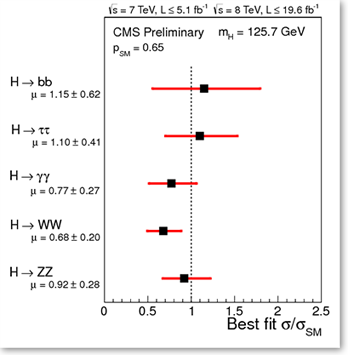fundamental? The modern atom model The scale of the atom What are we looking for? The standard model The standard model quiz
Shortcomings of the first data
The data were convincing but not perfect, and there were significant shortcomings. For one thing, by July 4, 2012, there weren't enough statistics to measure whether the rate at which this particle (the Higgs boson) decays to various collections of less massive particles (the "branching ratios") are those predicted by the Standard Model.
A "branching ratio" is simply the probability that a particle will decay via a given decay channel. These ratios are predicted by the Standard Model, and measured by observing the same particle decay over and over again.
The next plot shows the best measurements we can make of the branching ratios with the data available in 2013. Since these are the ratios to the Standard Model prediction, the expectation is to find 1.0. The data points are the current measurements. It's clear that the error bars (the red lines) are mostly still much too big to draw strong conclusions. These error bars will shrink as more data is recorded, and the data points may possibly move.

© CERN
How does one know when one sees a collision event if it is a candidate for a Higgs boson? There are unique characteristics that make these events stand out.





















